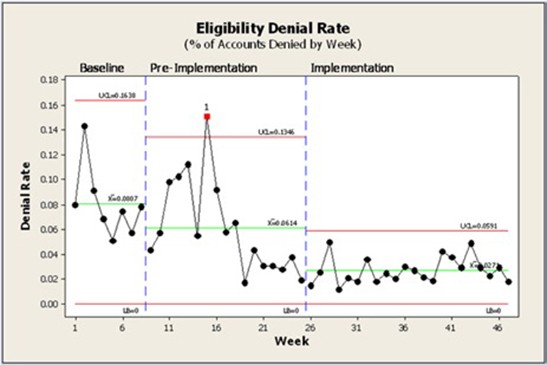Unless you relish leafing through months-old magazines, time spent in a waiting room can be frustrating. Akron Children’s Hospital—the largest pediatric health care provider in northeast Ohio—knows this. That’s why the hospital is using quality techniques pioneered in industry to reduce patient waiting times and make many other improvements. The hospital established its Center for Operations Excellence (COE) in 2008 to improve patient care using Lean Six Sigma. The center’s project leaders provide training and leadership to help the hospital boost efficiency, reduce errors and solve problems. "To verify the success of a project, we need to collect and analyze data before and after improvements are made," says Chris Weisbrod, one of the center’s four full-time project leaders. "We trust Minitab® Statistical Software to help us analyze our data and understand the results."
Challenge
Many potential "defects" can occur in a hospital. Time may be wasted moving equipment from room to room. Patients may lack wristbands, or get the wrong ones. Medical supplies may not be available when needed. Lean Six Sigma aims to reduce such "defects." In statistical terms, a 6 sigma process has just 3.4 defects in 1 million opportunities. That’s a success rate greater than 99%, which would be only a 3.8 sigma process. This goal of near-perfection is vital when lives are at stake. For example, if 500,000 surgeries are performed in a week, a 99% success rate would mean there were 5,000 defective procedures. Clearly, that is not good enough. At the 6 sigma level, that figure drops to just 1.7 defects. Figures like these explain Akron Children’s Hospital’s commitment to process improvement at the highest levels. But the benefits of quality improvement efforts need to be proven and backed up with reliable data. "If you want to achieve operational excellence, data has to be your best friend," Weisbrod says. "That’s where Minitab comes in."

Akron Children’s Hospital trusts Minitab Statistical Software when analyzing data for their quality improvement projects.
How Minitab helped
Minitab is designed to make it easy to analyze data—and understand what the analyses mean. Originally developed to help professors teach, it has become the world standard in statistics education. "From basic pie and bar charts to regression analysis, Minitab has the tools we need," notes Mike Antochow, the COE’s full-time data analyst. "Minitab is easy to use, but also incorporates all the methods and analytical power you need for even the most complex quality projects."
Many factors can lead to defects or cause variation in the complicated processes found in a hospital. Statistics can help identify which factors are the most important, enabling teams to focus improvement efforts where they will make the most difference. For example, the center’s project leaders frequently use Minitab to display process data in a time-ordered sequence called a control chart. These charts make it easy to distinguish normal variation in a process from variation caused by something unusual. For example, patient wait times inevitably have some variability. But variability that exceeds expectations may be due to factors that are not part of the normal process, and can be corrected. After corrections have been made, Minitab’s control charts help ensure the improvements remain effective and the process remains stable.

Minitab’s graphics clearly reveal the before-and-after impact of improvement efforts. This chart vividly displays the reduction in insurance eligibility denials after Lean Six Sigma improvements were implemented at an Akron Children’s Hospital regional pediatrics office.
Of course, statistical analysis is just one part of the quality improvement process, and the center’s project leaders have many other tasks. But when you don’t use statistics every day, how can you be sure you’re running the right analysis, or understanding your results correctly? " Minitab Help is a tremendous resource," Weisbrod says, "and the built-in StatGuide makes it even better. One helps you do your analysis properly, and the other helps you interpret what your analyses mean." Minitab’s multifaceted Help system offers instructions, examples, guidance for setting up your data, and information on calculations and methods. After you analyze the data, Minitab’s StatGuide™ provides easy-to-understand guidance for interpreting statistical tables and graphs.
The power of Minitab is being used to improve processes throughout Akron Children’s Hospital. Project leader Trauda Gilbert is using it to analyze data to help reduce the need for overtime in the hospital’s cytogenetics unit, while her colleague Anne Musitano is using it find ways to improve MRI scheduling efficiency. Along with the rest of their peers in the COE, they trust Minitab to provide the analyses they need in a way that’s easy for them—and the departments they work with—to access and understand.
Results
Akron Children’s Hospital has become a leader in applying Lean Six Sigma to health care with efforts like the COE’s "A3" program, which teaches Lean Six Sigma techniques to frontline staff. The first class of A3 participants went on to complete 28 projects that benefited patients, families, and staff, while saving the hospital an estimated $708,000 per year. In other projects, the Heart Center eliminated the need for patients to move from room to room during each visit, reducing average visits from 107 to 75 minutes and freeing up enough time to see two extra patients each week. The Outpatient Pharmacy slashed the time it takes to fill a prescription from 66 to about 45 minutes. Another project reduced eligibility denials at the Fairlawn office of Akron Children’s Hospital Pediatrics by 69%. And when sterile processing technicians couldn’t keep up with demand for clean surgical instruments, a $3.5 million expansion was suggested. Instead, the center facilitated a project in which the technicians redesigned their layout and processes to boost capacity, and confirmed the benefits with Minitab. The department now can handle up to 16,000 operations annually, up from 13,000 procedures a year.
The leaders in the Center for Operations Excellence have many other projects ahead of them, and they are looking to help other providers learn from their success. "Our goal is to set a standard of excellence at Akron Children’s Hospital that serves as a model for others around the nation," Weisbrod says. "You can always get better."

Organization
Akron Children's Hospital
Overview
- Serves a 25-county region, including all of northeast Ohio and western Pa.
- Operates two pediatric hospitals and offers services at nearly 70 locations
- Employs more than 3,900 people
- Invested approximately $250,000 in Center for Operations Excellence
Challenge
Implement Lean Six Sigma through every facet of the hospital’s services.
Products Used
Minitab® Statistical Software
Results
- $4.3 million in savings between April 2008 and May 2009
- Over 5,760 hours of patient wait time eliminated
- Eliminated over 4,560 hours of staff non-value-added time



